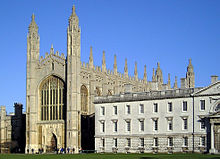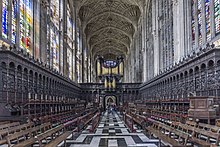King's College Chapel (Cambridge)
King's College Chapel (Chapel of King's College) is the chapel of King's College , which the University of Cambridge belongs.
The chapel was built by three successive Kings of England between 1446 and 1515 during the Wars of the Roses . It is considered an example of the Perpendicular Style . The large stained glass windows were not completed until 1531, the rood screen in Renaissance style was built from 1532 to 1536. The chapel is an Anglican house of worship that is home to the King's College Choir . The major landmark is often used as a symbol of the city of Cambridge. The chapel has been classified as a Grade I cultural monument since 1950 .
Construction of the chapel
King Henry VI. himself determined the dimensions of the college building. An entire district was demolished for this, including the church of St John Zachary. Of the detailed construction plans given by the king, only the chapel was realized. It is not certain who the builder was. It could have been the royal builder Reginald Ely ( fl. 1438–1471). Nicholas Close (or Cloos) († 1452), one of the first six fellows of the college founded in 1441 and priest at the abandoned church of St John Zachary, is called a surveyor , which was often understood as an architect. The king laid the foundation stone on the feast of St. James on July 25, 1446. When Henry VI. was discontinued in the course of the Wars of the Roses in 1461, the construction work initially ended. By then the foundations and the east wall were in place.
Only under Richard III. construction work was resumed. At the end of his reign in 1485, five yokes were completed and provided with a wooden roof so that they could be used for worship. Henry VII , the founder of the Tudor dynasty, visited the unfinished building in 1506. Under the influence of his mother Margaret Beaufort , he ensured that work was resumed and left a sum to ensure that the construction started by his deposed uncle after his Death could continue. In 1515 under Henry VIII the building was finished with the exception of the large windows.
The chapel contains the largest fan vault in the world, built by John Wastell from 1512 to 1515 . It also contains extraordinary medieval windows.
During the English Civil War , the church was used by Oliver Cromwell's troops. However, it was not destroyed because Cromwell had studied at Cambridge. Graffiti left behind by his soldiers still exists. Most of the window panes were removed from storage during World War II and the chapel remained undamaged.
window
The windows of King's College Chapel are some of the finest stained glass of their time. There are twelve large windows on each longest side and larger windows on the east and west ends. With the exception of the west window, they are of Flemish origin and date from 1515 to 1531. Four windows are works by Barnard Flower. Gaylon Hone and three partners created the east window and sixteen other windows between 1526 and 1531. The last four windows were made by Francis Williamson and Symon Symondes. The only modern window is the west window donated by King's Alumnus Francis Stacey in 1879.
Altar painting
The altar painting Adoration of the Magi is by Peter Paul Rubens , who painted it in 1634 for the Carmelite Convent in Leuven . When the monasteries in Belgium were dissolved in the course of Josephinism , the painting was sold to William Petty, 2nd Earl of Shelburne in 1788 . After his death it was bought by Robert Grosvenor, 1st Marquess of Westminster , whose descendant had it auctioned in 1959. The new owner, Alfred Ernest Allnatt, donated it to King's College. Before the picture could be placed in the chapel in 1968, the steps in front of the altar were removed so that it would not obstruct the east window. Lead coffins from the 15th to 18th centuries were found among the Tudor period , which were exhumed. So that the altarpiece did not appear too small under the east window, two empty side wings were added to the retable.
Rood screen
A large wood-carved rood screen separates the nave and the choir. He carries the choir organ. The rood screen was commissioned by Henry VIII to celebrate his marriage to Anne Boleyn . It is an early example of English Renaissance architecture and contrasts with the Gothic architecture of the chapel. Nikolaus Pevsner described it as "the most exquisite piece of Italian decoration surviving", the best preserved example of Italian furnishings in England.
organ
The history of the organs in the chapel of King's College has been proven to begin as early as the 15th century. According to sources, two organs were repaired between 1450 and 1451. A new building by the organ builder Thomas Browne is documented for the year 1508. This instrument was probably dismantled and sold after 1564. At the beginning of the 17th century, the organ builder Thomas Dallam built a new instrument. It was set up on an organ stage in 1617 by the organ builder Robert Dallam.
In the course of time, other instruments were built. The instrument in its present form goes back to the organ builders Harrison & Harrison, who reorganized and expanded the existing instrument in 1934. The last work took place in 2016. Today the instrument has 81 stops (including some transmissions) on four manuals and a pedal. The playing and stop actions are electro-pneumatic.
The striking organ case is one of the oldest in England, and probably comes from the Dallam instrument from the early 17th century. The case of the Choir Organ probably dates from the middle of the 17th century. The main case was doubled in depth in 1958 to encompass the expanded instrument.
|
|
|
|
|
||||||||||||||||||||||||||||||||||||||||||||||||||||||||||||||||||||||||||||||||||||||||||||||||||||||||||||||||||||||||||||||||||||||||||||||||||||||||||||||||||||||||||||||||||||||||||||||||||||||||||||||||||||||||||||||||||||||||||||||||||||||||||||||||||||||||
use
The chapel is used as a church, as well as for concerts and college events, including the traditional annual King's College Music Society May Week Concert , held on the Monday of May Week . The church interior has excellent acoustics . The world famous Choir of King's College, Cambridge was established. He sings almost every day during class, performs in concerts and in recordings for radio, CD and DVD. He is famous for the annual live broadcast of the Nine Lessons and Carols by the BBC on Christmas Eve, which is broadcast since 1928th The choir was directed by Stephen Cleobury from 1982 to 2019 . In another choir, King's Voices , students sing the Evensong weekly during the semester .
The major tourist destination is often used as a symbol of the city of Cambridge, for example in the city council logo.
literature
- Josephine Warrior, Tim Rawle: A Guide to King's College Chapel. Cambridge 1994, OCLC 1008205477 (reprints 1997 and other)
Web links
- King's College Chapel. King's College(English).
- The Kings College Chapel in 3D, GE4 Google Earth
- Cambridge, King's College School. In: Of Choristers - ancient and modern. December 21, 2004, archived from the original on July 20, 2011 (History of King's College Chapel).
Individual evidence
- ↑ King's College, Chapel. In: historicengland.org.uk . Accessed December 24, 2019 .
- ↑ a b c History of the Chapel. In: kings.cam.ac.uk. Accessed December 24, 2019 .
- ↑ Thomas John P. Carter: King's college chapel: notes on its history and present condition. Macmillan and Co, 1867, p. 10.
- ↑ David Ross: King's College Chapel, Cambridge. In: Britain Express. Accessed December 24, 2019 .
- ^ Lancelot Patrick Wilkinson: A Century of King's 1873-1972. King's College, Cambridge, 1980, ISBN 978-0-9502450-5-8 , pp. 130-131.
- ↑ Chainey Graham: A season for crying in the chapel: Millions will enjoy today's festival of carols from King's College, Cambridge. But Graham Chainey mourns a botched 'restoration'. In: The Independent . December 24, 1992, accessed March 14, 2017 .
- ^ Nikolaus Pevsner: An Outline of European architecture. Penguin Books, Harmondsworth, 7th Edition, 1963, pp. 292f.
- ↑ Information on the organ
- ↑ Manage your properties with our landlord portal. Cambridge City Council, accessed December 24, 2019 .
Coordinates: 52 ° 12 ′ 17 ″ N , 0 ° 6 ′ 59 ″ E



